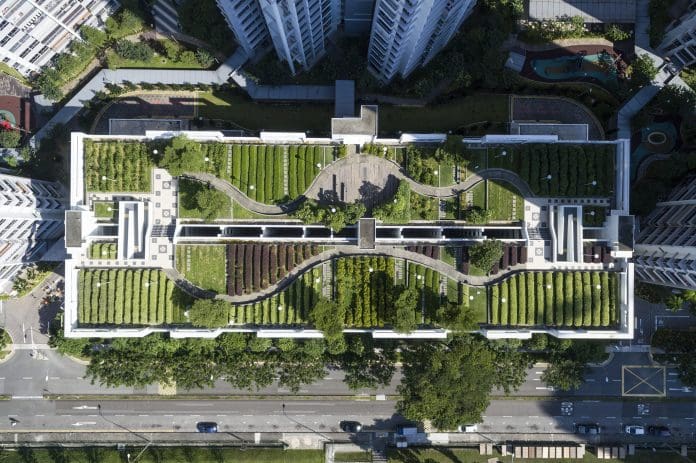Rapid population growth in cities and intensified climate change bring the challenges of limited urban space and more extreme weather conditions. Learn how activity roofs offer a solution by maximising space and improving overall quality of life
The world population is growing faster than ever, with more people migrating to our urban areas. It is estimated that 68% of the world’s population will live in urban areas by 2050. That’s an increase of 2.5bn people in our already crowded urban hubs. Public spaces will decrease further, and so will the quality of living.
Meanwhile, hotter summers make our cities sweltering. Heatwaves are now a recurring phenomenon. Air conditioning alone will not provide the solution and is not a sustainable answer.
Heavy rain turns our streets into swirling rivers. Our sewage system simply can’t cope with the vast amount of water that surges through it in such a short period of time.
Architects, planners and engineers play a crucial role in developing sustainable solutions that make our crowded cities pleasant places to work, live and visit today and in the years to come.
Smart spaces, smarter cities
While our cities are well-developed, certain useful urban spaces remain underutilised. For example, existing flat roofs are still untapped spaces.
Exploiting flat roofs provides an answer to many of the challenges that our growing cities face, including:
- Shrinking biodiversity.
- Greater demand for energy.
- Increased competition for land.
- The effects of climate change.
Flat roofs are used for many different purposes, from rooftop gardens that absorb CO2, boost biodiversity, and regulate temperatures to roofs that produce energy from solar panels and wind turbines.
Other uses, such as community roofs, offer social and recreational activities, adding value to properties and increasing income. Different functions are combined, increasing the value of flat roofs.
In essence, activity roofs play a key role in the smart and sustainable development of our urban areas.
They are a valuable tool for moving towards circular cities in which we make, use, reuse and recover materials, products and energy, reducing our impact on the environment.
Optimise space with activity roofs
Increasing urbanisation results in the use of more concrete and a reduction in open green spaces leading to a decrease in the quality of living.
By maximising the use of rooftops we can improve the space and optimise the environment.
For example, rooftop gardens are not only a visual benefit for cities, but also improve the quality of the air and encourages biodiversity. Green roofs reduce the urban heat effect, purify the air and collect rainwater. They also help to insulate building structures and improve their energy efficiency and performance.
Activity roofs can also provide a sense of community. With FOAMGLAS® insulation solutions, you can play a vital role in activating new and existing roof spaces contributing to healthier living now and in the future.
Our sustainable activity roof solution stands the test of time, a key component in the shift towards circular cities. Using FOAMGLAS® cellular glass insulation can help you optimise the energy performance of your building and opens up a world of possibilities.
Activity roofs can be a key part of our cityscapes, making them a smart investment today and for the next generation.
No compromises
When it comes to the roof of a building, no compromises should be made.
“Architects, planners and engineers play a crucial role in developing sustainable solutions that make our crowded cities pleasant places to work, live and visit today and in the years to come.”
A roof is meant to give you complete peace of mind throughout the lifetime of the building.
Possible problems that you may encounter can be easily prevented by working with the right materials and application to ensure qualitative performance over time.
What is a fully bonded roof?
FOAMGLAS® fully bonded roofs (also known on the continent as Compact Roofs) are a simple, robust and versatile roof build-up with the exceptional properties of FOAMGLAS® thermal insulation.
FOAMGLAS® cellular glass insulation is a lightweight, durable and rigid insulation material made up of millions of hermetically sealed glass cells.
This gives it exceptional protective properties such as incombustibility, superior compressive strength, guaranteed water and vapour tightness and long-lasting thermal insulation performance.
The compact build-up usually consists of three layers glued together, fully bonded and joints sealed with bitumen or cold adhesives:
- A bearing structure.
- FOAMGLAS® cellular glass insulation.
- A waterproofing layer.
FOAMGLAS® fully bonded systems give you the optimum solution for activity roofs. They are robust and easy to build systems that avoid the risks associated with multi-purpose roofs.
The fully sealed joints and bonding to the roof deck ensure that the insulation layer is completely watertight and compartmented.
Depending on the conditions and requirements of the project, there are different alternatives for a fully bonded system, either using cold adhesives, hot bitumen or a combination of the two, that complement a wide range of waterproofing methods.
Rapid population growth in cities and intensified climate change bring the challenges of limited urban space and more extreme weather conditions.
FOAMGLAS® fully bonded roof systems provide high quality solutions with time tested performance, contributing to a sustainable future, whilst maximising space and improving overall quality of life.
Owens Corning Insulation (UK) Ltd.
*Please note: This is a contributor profile.














